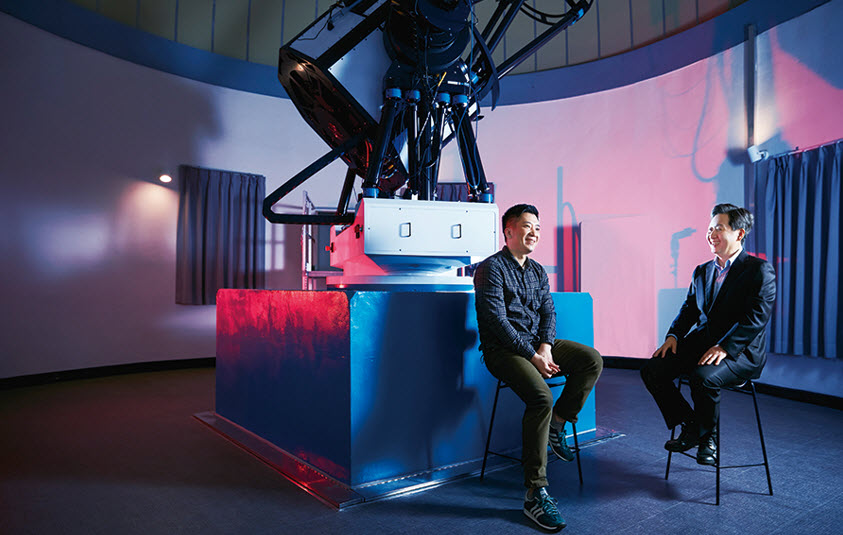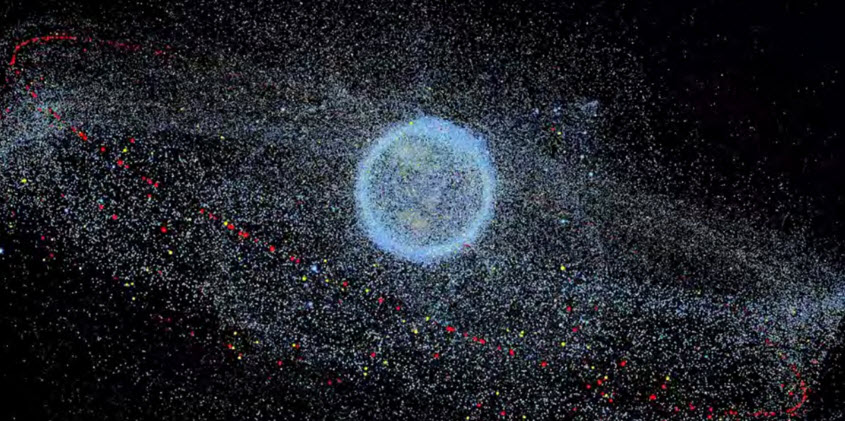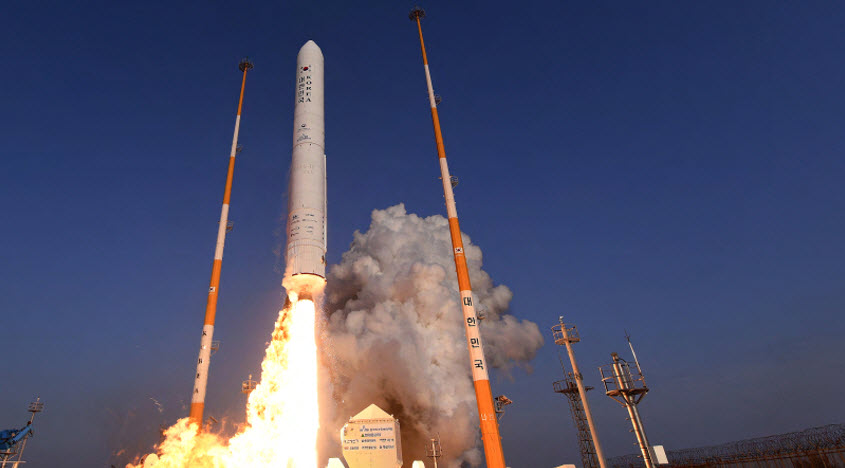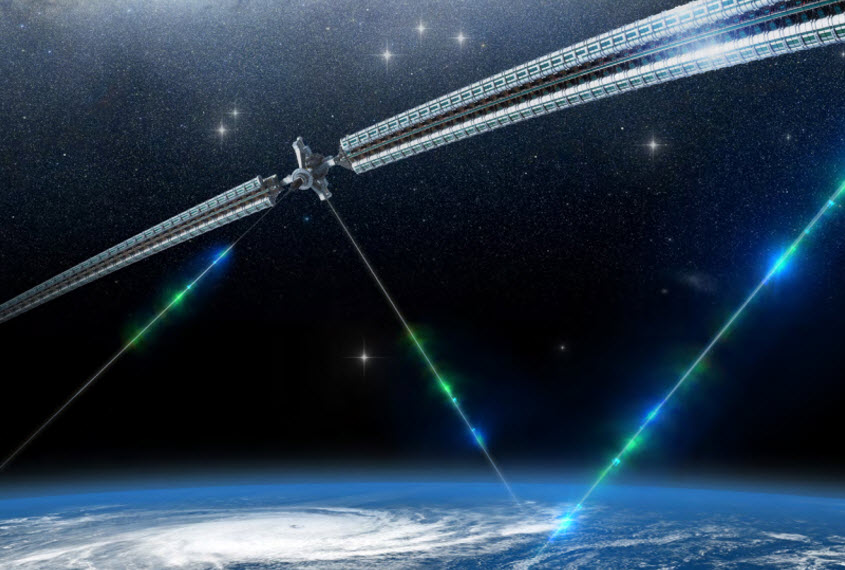
Film Director Seong-hui Cho (Department of Industrial Design, Class of 98), Professor Young bin Yoon (Department of Aerospace Engineering)
Scenes of “Space Sweepers” Becoming a Reality
Professor Yoon: I, as an aerospace engineer, was deeply impressed by the movie Space Sweepers. The movie deals with the space in 2092, a future world 70 years from now, but many of the scenes from the movie may happen within 30 years. I know that it is really difficult to produce a space movie in Korea, but how did you come to plan the movie Space Sweepers?
Director Cho: Well, Space Sweepers was planned by taking a very simple opportunity. About 10 years ago, I was talking with one of my acquaintances about space debris. I learned that the components from the space vehicles that we humans launch, disabled satellites or other various fragments are causing big problems. I thought that in the future with developed space technologies, anyone will be able to go to the space, and new jobs will emerge. So, I imaged what will happened to the earth at that time.
Professor Yoon: As you said, space debris is the problem for which a solution is searched worldwide. There are more than 100 million pieces of waste having a size of 1 mm or larger and travelling the earth’s orbit at a speed of 7 to 8 km/sec. If we fail to solve this problem, the pieces of waste will collide with each other to produce more fragments, bumping into the satellites or falling down to the earth. Efforts are taken by many countries. The robot in the film, named as ‘Updongi’, throws a harpoon to catch the waste, and that is one of the actually applied methods of waste removal. I thought that you must have studied the issue a lot before producing the movie.
Director Cho: How dare I can say that I’ve ‘studied’ that? (Laugh). I learned that the space debris may be gathered by various methods, beside those shown in the movie, for example, by using a powerful magnet or by spraying a freezing gas to drop the debris down. However, it’s a movie anyway, and so I chose the method of throwing a harpoon for fancy action scenes. That is the least efficient one among the methods that are currently used.

Space Sweepers, the movie expressing the space in 2092, shows space sweepers who collect space debris. (Image source: Netflix)
Space is difficult both in the movie and the reality.
Professor Yoon: Space Sweepers was meaningful to me, because it was the first Korean movie that showed the space realistically. The computer graphics were so realistic that I should have not watched the movie on television.
Director Cho: Thank you very much. From the technical point of view, the Korean artists are never behind the United States. However, producing an SF movie is difficult, because the investment, the period and other conditions should be satisfied. Thinking about that, space is difficult both in the movie and the reality. What are the issues in the reality?

An illustration of space debris distributed in the earth’s orbit. The red dots represent satellites, the yellow dots the rocket bodies, the green dots the objects related to their missions, and the blue dots their fragments (Image source: European Space Agency (ESA))
Professor Yoon: There are similar difficulties in the reality. Since the research requires a huge amount of capital, Korea’s technological power is way behind Russia or the US, the countries that initiated the development of launch vehicles far earlier than Korea. In addition, because the technologies for rocket launch vehicles are closely related to national defense, none of the states having the technologies transfer them to a third state. The Rocket Propulsion Laboratory in SNU was also able to learn the technologies through civilian exchange with the universities in Russia. Thanks to the efforts made by many researchers, our satellite technology is as high as the world powers. Our launch vehicle technology is behind the world powers. If we successfully launch the Nuri vehicle in October, we will have a launch vehicle produced only with the Korean technologies. Hence, this year is critical to the space development in Korea.
Director Cho: You must have undergone many difficulties to master and realize the technologies exclusively possessed by other countries. I truly respect you and the students working together. I recently heard that the space development projects are shifting to the civilian sector.
Professor Yoon: Exactly. In July last year, SpaceX, the civilian space enterprise in the US, successfully recycled a rocket within the shortest time, which was a game-changing event. Falcon 9, the rocket used to launch the first civilian manned spaceship, Crew Dragon, was recycled within 51 days to launch the next spaceship. The launching of the NASA’s space shuttle, which have already retired, used to cost about 1.5 trillion KRW, but SpaceX cost just about 163 billion KRW. That reduced the rocket development expense to one hundredth within 40 years. The experts forecast that more expense may be reduced within a shorter time. If that happens, the background of Space Sweepers will come to reality earlier than 70 years.
Director Cho: It’s really interesting and exciting that my movie may come true, but I hope the migration to another planet due to the devastation of the earth should never come true (Laugh).

The successful launching of the Nuri test vehicle in 2018. The Nuri vehicle that passed the final performance test in March will be launched in October. (Image source: Korea Aerospace Research Institute (KARI))

A 3D rendering of an imaginary space elevator (Image source: NASA).
A Special Space That Enables One to Bear Infinite Imagination
Director Cho: Interestingly, the universe is the field of science and engineering and at the same time, it is a space that is highly related to philosophy and humanities. There is the saying, ‘We are nothing but dust in the universe.’ Also, there are beguiling logics of science including the relativity theory, which teaches that the space-time is changed over the black hole. In the industry of creative arts, many works are prepared with the universe or quantum physics as a material. Although the arts may be fictions, they help us to imagine the future that will come.
Professor Yoon: You mentioned ‘fictions,’ but the imagination of the creative producers serves as an important starting point of research. Imagination is actually behind our travel to the moon. Jules Verne’s science fiction, From the Earth to the Moon, published in 1865, includes a story that was considered as ridiculous at that time, to put a man into a cannon and boom it to the moon. The novel was popular among the young people, and the people’s interest in the moon was greatly increased. On July 20, 1969, about one century after the publication of the novel, the humankind really stepped on the moon. I sometimes envy your abundant imagination, because I have to conduct studies based on accurate theories and numbers. How did you come to be a film director?
Director Cho: In fact, I’m wondering if there was a specific opportunity. I loved to make videos and operated a small CG business. After some time, I found myself as a film director. When I was attending the SNU, I was enthusiastic about the play club activities. In the SNU Fine Arts College Dramatic Arts Research Group, which has continuously performed plays until now, I used to write scenarios and act in plays. I am rather wondering how you firstly faced aerospace engineering, where there is no room even for little tricks. (Laugh).
Professor Yoon: When I was 7 years old, I watched on TV the human travel to the moon. I was spending my young years in the era of the space rate. The very scene that I watched on TV made me to dream about the universe. I decided to major aerospace engineering when I was in high school. At that time, Korea’s basis for aerospace engineering was so poor. When attending SNU and studying in the US, I was determined to join NASA. I was unable to realize the dream due to the citizenship issues, but I have been working with the universe for 25 years, teaching my students in my alma mater.
Director Cho: I think it is because of the Korean researchers and students, including you, that our aerospace engineering technologies have been drastically developed, starting way behind the world powers. I really like to thank you and tell you that I am proud of you, as one of Korean citizens. I truly enjoy the conversation with you today, talking about the curiosity that I had about the universe while making Space Sweepers. Like the zeal that you and the SNU Rocket Propulsion Laboratory have about universe, I will do my best to play my roles in making stories and fueling imagination. Professor Yoon: I also enjoyed the time with you. Please make good movies more. I hope your movies can provide the driving force to our young children and students to dream about their future. Thank you very much.

